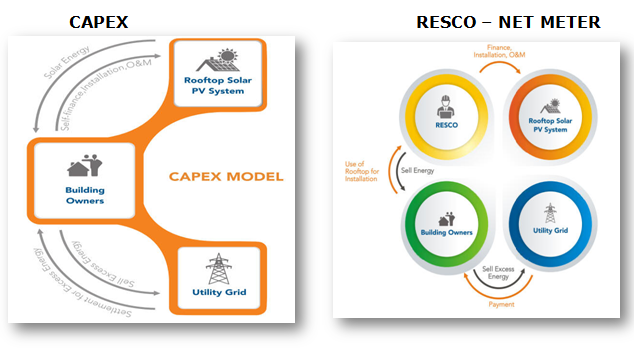Roof Top Solar Solution
In grid connected rooftop or small SPV system, the DC power generated from SPV panel is converted to AC power using power conditioning unit and is fed to the grid either of 33 kV/11 kV three phase lines or of 440V/220V three/single phase line depending on the local technical and legal requirements.
These systems generate power during the day time which is utilized by powering captive loads and feed excess power to the grid. In case, when power generated is not sufficient, the captive loads are served by drawing power from the grid.
The concept of rooftop solar is based on the scale of the PV Plant rather than the fact whether it is situated on a roof/terrace or not. Hence, the definition of RTS also includes small solar plant on the ground.

BENEFITS FROM THE GRID CONNECTED ROOFTOP SOLAR SYSTEM:
1. Utilization of available vacant roof space.
2. Low gestation period.
3. Lower transmission and distribution losses.
4. Improvement in the tail-end grid voltages and reduction of system congestion;
5. Loss mitigation by utilization of distribution network as a source of storage through net metering.
6. Long term energy and ecological security by reduction in carbon emission.
7. Abatement of about 60 million tones of CO2 per year over its life cycle.
8. Better Management of daytime peak loads by DISCOM/ utility.
9. Meeting of the renewable purchase obligations (RPOs) of obligated entities which are targeted at 8% of electricity consumption
10. Minimal technical losses as power consumption and generation are co- located.
METERING ARRANGMENT
Net metering systems are primarily aimed at providing an opportunity to consumers to offset their electricity bills, wherein a single meter records both import of conventional energy from distribution grid and export of solar energy into distribution grid. Thus, net metering allows the final user to credit produced energy in the grid and is also promoted as a preferred option

BUSINESS MODEL

Mainly two models for Solar Roof Top Installation are popular in India
1. CAPEX – Capital Expenditure provided by Roof Owner
2. RESCO – Capital Expenditure provided by 3rd party
Financial Assistance is provided by Central Government-MNRE @ CFA up to 30% of benchmark cost for General Category/UTs and up to 70% of benchmark cost for Special Category states i.e. North Eastern State i.e. NE including Sikkim, UK,HP, J&K, Lakshadweep, Andaman & Nicobar Islands. – Applicable for – Residential, Private Institutes, Social Sector etc…